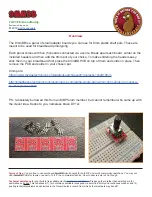
Maintenance — Type 130
4-2
AA
Total dc current from the rectifier should be about 40
ma, of which 21 ma goes to the circuits connected to the
150-volt bus and the remainder, about 20 ma, goes through
the regulator tube, when the ac supply is at 115 volts. Cur -
rent to other circuits connected to the 270-volt bus is but
fraction of a milliampere.
You can check the indicating meter by connecting another
milliameter across it. The meter is connected to the +150-
volt bus, so be careful not to get a terminal grounded.
The variable oscillator may be checked for operation by
connecting an oscilloscope to the GUARD VOLTAGE
terminal. The guard voltage will be about one volt peak-
to-peak at 124 to 140 kc. The fixed oscillator can be check-
ed at point 6 of V45. These points can also be checked with
an ac voltmeter capable of reading a fraction of a volt at
140 kc.
This is a fairly complex electronic device and there is no
simple way to find troubles. With a good understanding of
the circuits you will be able to make a good guess at the
source of the trouble from the symptoms. Be sure that any
difficulty you are having does not come from the settings
of the front panel controls.
Soldering and Ceramic Strips
Many of the components in your Tektronix instrument are
mounted on ceramic terminal strips. The notches in these
strips are lined with silver alloy. Repeated use of exces-
sive heat, or use of ordinary tin-lead solder will break down
the silver-to-ceramic bond. Occasional use of tin-lead solder
will not break the bond if excessive heat is not applied.
If you are responsible for the maintenance of a large
number of Tektronix instruments, or if you contemplate
frequent parts changes, we recommend that you keep on
hand a stock of solder containing about 3% silver. This
type of solder is used frequently in printed circuitry and
should be readily available from radio-supply houses. If you
prefer, you can order the solder directly from Tektronix in
one-pound rolls. Order by Tektronix part number 251-514.
Fig. 4-1. Soldering tip preparation.
Because of the shape of the terminals on the ceramic
strips it is advisable to use a wedge-shaped tip on your
soldering iron when you are installing or removing parts
from the strips. Fig. 4-1 will show you the correct shape for
the tip of the soldering iron. Be sure and file smooth all
surfaces of the iron which will be tinned. This prevents
solder from building up on rough spots where it will quickly
oxidize.
When removing or replacing components mounted on the
ceramic strips you will find that satisfactory results are ob-
tained if you proceed in the manner outlines below.
1. Use a soldering iron of about 75-watt rating.
2. Prepare the tip of the iron as shown in Fig. 4-1.
3. Tin only the first 1/16 or 1/8 inch of the tip. For
soldering to ceramic terminal strips tin the iron with
solder containing about 3% silver.
4. Apply one corner of the tip to the notch where you
wish to solder (see Fig. 4-2).
5. Apply only enough heat to make the solder flow freely.
6. Do not attempt to fill the notch on the strip with solder;
instead, apply only enough solder to cover the wires
adequately, and to form a slight fillet on the wire as
shown in Fig. 4-3.
Fig. 4-2. Applying iron tip to strip.
Fig. 4-3. Fillet on wire.
Summary of Contents for Type 130
Page 1: ......
Page 2: ......
Page 3: ......
Page 4: ......
Page 5: ......
Page 6: ......
Page 10: ...Operating Instructions Type 130 2 2 AA...
Page 20: ......
Page 26: ...S 30 Delta Standard Type 130 6 2 AA...
Page 28: ......
Page 48: ...7 18 DIAGRAMS TYPE 130 AA DIAGRAMS...
Page 51: ...AA PARTS LIST TYPE 130 7 21 Figure 7 5 Range Capacitors and Power Supply...
Page 53: ......
















































